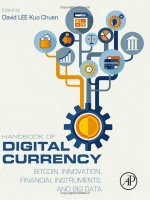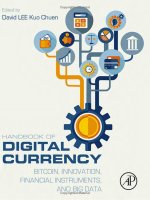courser web intelligence and big data 4 load lecture slides
Bạn đang xem bản rút gọn của tài liệu. Xem và tải ngay bản đầy đủ của tài liệu tại đây (820.39 KB, 17 trang )
Load
-‐
II
big
data
technology
week
3:
map-‐reduce
and
programming
assignment
week
4:
distributed
file-‐systems,
databases,
and
trends
distributed
file
systems
(GFS,
HDFS)
Master
(GFS)
Name
Node
(HDFS)
…/pub/<file>
1
Client
-‐
‘Cloud
Application’
replicas
2
XXX
…
offset
EOF
Chunk
Servers
(GFS)
Data
Nodes
(HDFS)
…/pub/<file>
overview
of
relaConal
databases
c
B+ -‐tree
Index
c
c
c
Join
Index
c
c
c
c
Date Month City Sales
NYC 10K
Records
Jan
Month Sales
00 10K
00
15K
City Sales
010.. 10K
00
01
Pages
of
Rows
Row
Oriented
Database
Pages
of
Column
Projections
Column
Oriented
Database
OLAP
(“online
analyCcal
processing”)
e.g.:
select
SUM(S.amount),
S.pid,
P.catname
from
S
where
S.did=T.did
S.pid
=
P.pid
and
T.qrtr
=
3
group
by
catname
*
Product Dimension
1
-Product ID
-Category ID
-Category Name
1
Location Dimension
-Address ID
-City
-State
-Country
-Sales Region
1
1
*
*
Sales Facts
-Product ID
-Customer ID
-Address ID
-Day ID
-Quantity
-Amount
*
Time Dimension
-Day ID
-Year
-Financial Year
-Quarter
-Month
-Week
databases:
why?
• transacCon
processing
(ACID
properCes)
• SQL
–
queries
and
indexing
Ø
transacCon
processing
not
need
for
analyCcs
– though
there
may
be
advantages
in
not
having
to
move
data
out
of
a
transacCon
store
if
avoidable
Ø
queries
–
yes,
but
if
large
volumes
of
data
are
being
touched
(e.g.
joins,
large-‐scale
counCng,
building
classifiers,
etc.);
indexes
become
less
relevant
o resilience
to
hardware
failures,
which
MR
provides,
is
vital.
Ø but
OLAP
–
can
be
viewed
as
compuCng
a
part
of
the
joint
distribuCon
P(f1…fn)
–
using
intuiCon
to
select
parallel
databases
Shared
Memory
Shared
Disk
Processor
Processor
Processor
NAS
/
SAN
Processor
Disk
/
SAN
Storage
Network
Processor
Share
Memory
SMP
Operating
System
Processor
CPU
CPU
CPU
Network
Disk
Disk
Disk
Shared
Nothing
database
evoluCon
noSQL
databases
• no
ACID
transacCons
• sharded
indexing
• restricted
joins
• support
columnar
storage
(if
needed)
in-‐memory
databases
• real-‐Cme
transacCons
• variety
of
indexes
• complex
joins
big-‐table
(HBase)
Metadata
Table:
Hstore (Hbase)
SSTable (Bigtable)
Table
1
Metadata
Tablets/Regions
Root
Tablet/Region
Master
Server
=
G FS/HDFS
files
.
.
.
Region/
Tablet
Table
N
Region
/
Tablet
Server
e.g.
indexing
using
big-‐table
location:city
NYC
Txn ID
0088997
location:region
US
East
Coast
US
North
East
sale:
value products:
details
products:
types
ACME
Detergent
XYZ
Soap
KLLGS
Cereal
A
Cleaner
Breakfast
Item
$
80
Txn:
0088997
Prod:
ACME,
Amount:
$80
City:
NYC,
Status:
Paid
10:08:12::12:19
Prod:
ACME,
Amount:
$80
City:
NYC,
Status:
Pending
13:07:12::10:39
Invoice
Table
key
key
key
key
Inv/Prod:
CDHE
key
key
Inv/Prod:
BBME
key
key
Inv/Prod:
ACME
key
Inv/City:NYC/Status:Pending
Inv/City:NYC/Status:Pending
Inv/City:NYC/Status:Paid
Composite
Index
Tables
key
key
key
Inv/Amount:$60
Inv/Amount:$80
key
Inv/Amount:$86
key
key
Single
Column
Index
Tables
mongo
DB
documents
shards
indexes
–
incl.
text
map-‐reduce
•
(JavaScript)
Dremel
–
new
‘kid’
on
the
block?
powers
Google’s
“BigQuery”
two
important
innovaCons:
• columnar
storage
for
nested,
possibly
non-‐unique
fields
–
leaf
servers
• tree
of
query
servers
pass
intermediate
results
from
root
to
leaves
and
back
Ø orders
of
magnitude
bejer
than
MR
on
petabytes
of
data
–
speed
and
storage
SQL
evoluCon:
SQL-‐like
MR
coding
Map
-‐>
[(AddrID,Sale/City)]
Pig
Latin:
tmp =
COGROUP
Sales
BY
AddrID,
Cities
by
AddrID
ioin =
FOREACH
tmp GENERATE
FLATTEN(Sales),
FLATTEN(Cities)
grp =
GROUP
join
BY
City
res
=
FOREACH
grp GENERATE
SUM(Sale)
Reduce
-‐>
(AddrID,
[(Sale,City)]
Map
-‐>
(City,
[(Sale)])
Reduce
-‐>
(City,
SUM(Sale)]
HiveQL:
INSERT
OVERWRITE
TABLE
join
SELECT
s.Sale,
c.City FROM
Sales
s
JOIN
Cities
c
ON
s.AddrID=c.AddrID;
INSERT
OVERWRITE
TABLE
res
SELECT
SUM(join.Sale)
FROM
join
GROUP
BY
join.City
SQL:
SELECT
SUM(Sale),
City
from
Sales,
Cities
WHERE
Sales.AddrID=Cities.AddrID GROUP
BY
City
SQL
evoluCon:
in-‐DB
staCsCcs,
in
parallel
map-‐reduce
evoluCon:
iteraCon
many
applicaCons
require
repeated
MR:
e.g.
page-‐rank,
conCnuous
machine-‐learning
…
1. iterate
MR
but
make
it
more
efficient:
avoid
data
copy
(HaLoop,
Twister)
2. generalized
data-‐flow
graph
of
map-‐>reduce
tasks
tasks
are
‘blocking’
for
fault-‐tolerance
(Dryad/LINQ,
Hyracks
…)
3. direct
implementaCon
of
recursion
in
MR
how
to
recover
from
non-‐blocking
tasks
failing?
graph
model:
(Pregel,
Giraph)
stream
model:
(S4)
hidden-‐agenda
again…
is
the
brain’s
processing
highly
parallel
–
yes
does
the
brain
do
map-‐reduce
–
probably
not
does
the
brain
do
indexing
/
databases
–
no
does
the
brain
classify
–
appears
to
do
so,
yes
so
how,
i.e.
what
is
its
architecture?
we’ll
return
to
this
quesCon
in
‘predict’
summary
• distributed
files
–
2nd
basic
element
of
big-‐data
• what
databases
are
good
for
– and
why
tradiConal
DBs
were
a
happy
compromise
• evoluCon
of
databases
• evoluCon
of
SQL
• evoluCon
of
map-‐reduce
Next
week
(5)
Ø no
lecture;
only
‘office
hours’
based
on
forum
Ø following
week
(6):
Learn:
‘facts’
from
data









